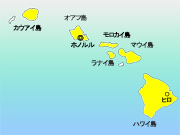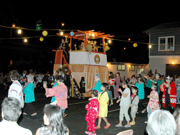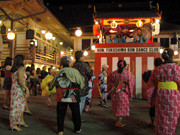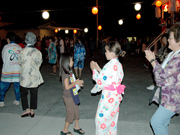Who would imagine that Hawaii, the Pacific Paradise is “The Kingdom of Bon Dance”?
What we saw in the streets of Honolulu, Oahu and the fertile plain of Hilo in the island of Hawaii was unmistakably “Bon Dances”. The Japanese people who have the same roots as us, and other people from various ethnic origins get together in one circle and dance “Bon Dance”. Dances such as “Tanko Bushi”, “Matsuken Samba”, and traditional dances are danced. They dance pretty well. Some time ago in Japan, there must have been times when everyone got together and enjoyed Bon Dance. The time and space of Bon Dance under the moonlight in Hawaii made us feel somewhat mystifying.
We pursued the unknown relation between the Bon Dance in Japan and that in Hawaii over the edge of horizon.
The distribution of Bon Dance in Hawaii
The Hawaiian Islands are located in the center of the Pacific Ocean and they are an archipelago made up of over 130 islands. Bon Dances are danced in the main 6 islands where ordinary people can enter among with the 8 islands where people inhabit (chart below). The number of locations where Bon Dance is danced is approximately 100. It can be widely seen in the city area where the populations concentrate such as Honolulu in Oahu Island and Hilo in Hawaii Island. It is also widely distributed in other areas and islands where many sugar plantation spread in the past.
Hawaii is literally “The Kingdom of Bon Dance”
Hawaii Island observed from the sky
Chart 1 The distribution of Bon Dances among the Hawaiian Islands
Bon Dances are still danced in the main 6 islands (yellow).
The characteristics of the Bon Dance in Hawaii
Bon Dance in Hawaii settled to and expanded mainly by the Japanese immigrants and their community who came to Hawaii as workers of sugar plantation before WW 2, and their descendants
With the dynamic history of the Japanese immigrants and their rich and varied lifestyle, Bon Dance in Hawaii is something very interesting. Also, it provides us with many valuable perspectives in thinking about “What is Bon Dancing?”
The characteristics that must be paid attention are the following points. Let’s look into the details from the following pages.
Time They are held mainly in the “Obon” period as is the same with Japan. However, they are held on the weekends of June through September which is a long period of time
Location
The location is mostly the gardens of Buddhist Temples
Parent Organization The actor of the Hawaiian Bon Dance culture is the community of the Japanese immigrants and their descendants. You must take notice to the point that the immigrants from Okinawa and their community are succeeding the unique Bon Dance culture besides the immigrants from the mainland Japan mainly from West Japan
Participants Befitting to the contemporary condition of the multiethnic society Hawaii, nowadays, Japanese immigrants and people of various ethnic origin participate in this event which is open to everyone.
Dance and Music The music people dance to are media series music and modern style music such as Tanko Bushi and Pokemon Ondo, just the same as in the present Japan. The point that people still enjoy the traditional dance music (live performance) which came down before the WW 2 is very important in the Bon Dances of Hawaii.
Bon Dances that we visited
The Shonan Bon Dance Workshop visited the following Bon Dances in August 2008
The moving image of Bon Dance
August 8, 2008 Pearl City, Oahu Island
Pearl City Hongwanji Bon Dance
The first Bon Dance overseas that we visited is the Pearl City Hongwanji Bon Dance. The mood of the venue is almost the same as that in Japan, but the dancing circle is multi-ethnic and impactful. We felt a sense of defeat, since the dancers danced so well. The most popular dance was the traditional “Fukushima Dance” in live performance. It was very sensational.
08/08/08
Shingon Mission of Hawaii Bon Dance
It’s a little past 10:00 PM. We participated in another Bon Dance in a Shingon Mission Temple near our hotel in Ala Moana. Luckily, we could see another traditional dance music “Iwakuni Dance” and were inspired to it. With an umbrella in his hand (which is quite popular in the Kansai region), the voice chairman started to sing “Nikudan Sanyuhshi (three hand-in-hand warriors), and this song was sung before WW 2. The drumming of the blue eyed trio was pretty good.
08/08/09
Hilo Higashihongwanji Mission Bon Dance
The next day we got on an airplane and flew to Hilo in Hawaii Island. We stayed one more day and participated in a Bon Dance held in an island which has a deep historical relationship with the Japanese immigrants.
Although it is a cozy Bon Dance in the countryside, it has an air of excitement. We were surprised to the fact that it has so many repertoires such as Bon Dances of the Hongwanji group and Kamehameha Ondo. Anyway, the most popular dance was the live performance of “Fukushima Odori”.
- 1.The distribution of Bon Dance in the overseas.
- 3.The parent body and the participants of Bon Dance
- 4.The schedule of Bon Dance
- 5.The location of Bon Dance
- 6. ”Dance Tunes” and their types
- 7.The composition and fashion of Bon Dance
- 8.The composition of “Odori-kyoku”-Hondo type and Okinawan type
- 9. Bon Dancing in Hawaii : The lyrics and refrains
- 10. Bon Dancing in Hawaii : History
- 11.Talking about Bon Dance in Hawaii : Professor Judy Van Zile from The University of Hawaii








